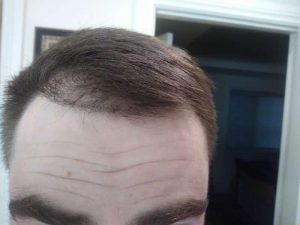Hair Transplant Speed
Hair transplants may damage existing hair through a process called shock loss, which tends to occur when the patient has limited spacing between existing hairs.
What Impact Does a Hair Transplant Have on Existing Hair?
A hair transplant procedure can cause physical trauma to the existing hair surrounding the grafts through a phenomenon known as shock loss. Receiving a hair transplant requires a surgeon to make tiny incisions to extra hair follicles.
The hair follicles are then transplanted to the recipient area, which may cause trauma to existing hair.
The hair around the donor area may also suffer from shock loss. The trauma causes native hairs to fall out.
The hair loss typically occurs within a few days of the surgery but is often temporary.
Most patients notice regrowth within two to six months.
Along with shock loss, patients should notice the loss of newly transplanted hair. The transplanted hair starts falling off about six weeks after surgery.
New hair typically emerges after another six weeks.

What Do Clinics Do to Minimise Hair Damage?
Some patients are more prone to shock loss. For example, older individuals who are already experiencing significant balding are more likely to notice hair loss.
Clinics may use several methods to help reduce the risk of hair damage, including shaving the recipient area, limiting the number of grafts per transplant, and prescribing medication.
Shock loss is more common with the Follicular Unit Transplant (FUT) method, which involves removing a narrow strip of the scalp.
The larger grafts lead to a more severe risk of shock hair loss compared to the small grafts completed with the Follicular Unit Extraction (FUE) method.
Some hair transplant clinics recommend micrografting FUE transplant procedures to limit the occurrence of hair loss after the surgery. Micrografting involves the use of smaller grafts, which causes less trauma to the scalp.
Shaving the Recipient Area May Limit Shock Loss
The recipient area is the portion of the scalp receiving the grafts. Shaving this area may minimise the risk of shock loss by giving surgeons a better view.
After shaving the head, surgeons can obtain the proper angle and spacing to limit trauma to adjacent hair follicles.

Limiting the Number of Grafts Completed
Surgeons may avoid implanting grafts too densely. Limiting the number of grafts during the transplant may limit the risk of trauma by providing more space around the natural hairs.
The typical hair transplant session includes 4,000 to 6,000 grafts. Some surgeons may recommend limiting the session to 2,000 grafts to avoid trauma to the capillary vessels.
Completing fewer grafts during a single transplant process also reduces the duration of the surgery and recovery time. With a shorter procedure, surgeons may use less anaesthesia, which limits the trauma to the scalp.
Medications for Reducing Shock Loss
Patients may receive medications to help with hair regrowth and reduce the risk of shock loss.
Minoxidil (Rogaine) and Propecia (Finasteride) are often prescribed to preserve the health of the original hair follicles.

Along with protecting against shock loss, medications may lead to moderate regrowth in some of the balding areas. But their main use is preventing further hair loss.
Minoxidil enlarges hair follicles to promote hair growth while Propecia reduces the conversion of testosterone to dihydrotestosterone (DHT), which is a leading cause of balding.
Tips for Minimising Damage to Existing Hair
Patients should also follow the aftercare instructions provided by the clinic to minimise the risk of hair damage.
For example, patients are typically advised not to wash their hair for at least 48 hours after the transplant.
After three days, patients may resume washing their hair but should avoid being too aggressive. Wash your hair gently using cool or warm water.
The most important step for reducing the risk of damage to existing hair is to choose a reputable clinic. Mistakes and improper transplants are two of the leading causes of shock loss.
Experienced surgeons understand the risks and how to minimise them.
During the hair transplant process, some surgeons may use excessive local anaesthesia to numb the scalp, which can increase the risk of hair loss. Excessive use of epinephrine, Marcaine, and lidocaine may also cause shock loss.
Incorrect use of these medications may cause an increase in adrenaline, which adds to the risk of hair loss.

Pharmacist with special interest in hair loss and hair transplantation.
Read my book on hair transplants in Turkey on Amazon:
https://track.more-info.co.uk/amazon/authorprofile

